Sept 2009
Sept 2009 sadminA HOTLINE TO PRESIDENT ZUMA
A HOTLINE TO PRESIDENT ZUMA sadminOrdinary citizens now have a chance to speak to President Jacob Zuma to voice their concerns and complaints. This follows the setting up of the presidential hotline earlier this month and a public liaison 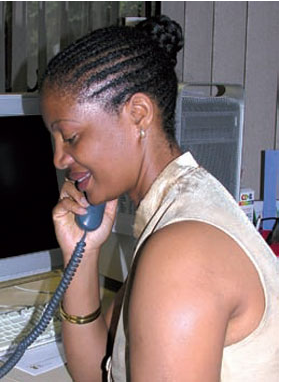 service in The Presidency. While members of the public will not always speak directly with the President, he will attend to callers as and when he finds time from his presidential duties. He will then direct their enquiries to the relevant department or local municipalities.
service in The Presidency. While members of the public will not always speak directly with the President, he will attend to callers as and when he finds time from his presidential duties. He will then direct their enquiries to the relevant department or local municipalities.
The hotline was among President Zuma's priorities during his election campaign. At the time, he said complaints that came through would be attended to as soon as possible.
About 50 call centre agents will be employed to handle calls from the public.
Members of the public are urged not to abuse the hotline for malicious purposes, but to report only serious matters. The Presidential Hotline Call Centre is operational between 6 and 10 pm from Mondays to Fridays.
ALL MUST JOIN IN THE EXCITEMENT
ALL MUST JOIN IN THE EXCITEMENT sadminThe success of the FIFA Confederations Cup held in June this year, has showed the world that South Africa is ready to host the 2010 World Cup. The 2010 Mass Mobilisation Programme played an 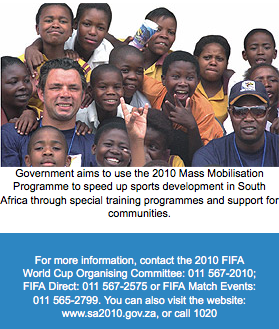 important role in creating a positive mood among South Africans during the tournament and beyond.
important role in creating a positive mood among South Africans during the tournament and beyond.
The 2010 Mass Mobilisation Programme aims to ensure that all South Africans are part of the 2010 FIFA World Cup excitement. It encourages and supports communities throughout South Africa to participate in sport and makes them aware of the benefits of sport. It also aims to ensure that people living outside the host cities do not feel left out.
Base camps
The programme includes road- shows to all the provinces. The road shows focus on non-hosting municipalities. This means they have not been chosen to host the 2009 Confed Cup and are not hosting the 2010 World Cup.
But these municipalities also have an important role to play. Some of them will serve as base camps for countries that participate in the 2010 World Cup. Participating teams will use facilities like accommodation and training stadiums.
During the roadshows, a publicity bus travels to the identified sites to create awareness about the World Cup.
The 2010 Ambassadors and the 2010 FIFA World Cup official mascot, Zakumi, also give out information about the tournament. The programme targets youth in all nine provinces, with 40 per cent of the participants being women.
So far, former football stars, who are now 2010 Ambassadors like Phil Masinga, Mark Fish and Desiree Ellis, have presented coaching clinics for young people during the road shows.
Activities of the programme also include life skills and coaching clinics for at least 290 coaches.
Partnership
The Mass Mobilisation Programme roadshow is a partnership between government, represented by the Department of Sports and Recreation, and the 2010 FIFA World Cup Organising Committee.
- Mbulelo Baloyi
AN INVALUABLE EXPERIENCE!
AN INVALUABLE EXPERIENCE! sadminWhat I have learned is that South Africans should all work together as one nation, said Confed Cup volunteer, Nannikie Mogwasha. Mogwasha, a 23-year old business management student in Tshwane and a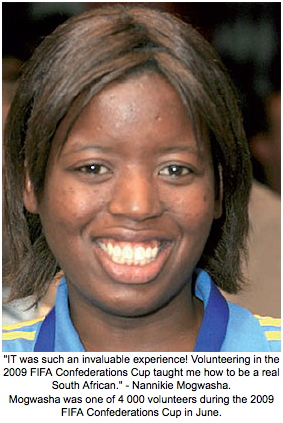 part-time waitress, was a volunteer team leader at Loftus Versfeld Stadium.
part-time waitress, was a volunteer team leader at Loftus Versfeld Stadium.
"What I found to be very important was showing our visitors how beautiful and diverse our country and its people are," said Mogwasha. "Seeing the joy on their faces made me to feel that I had been a good ambassador for my country."
Working together
Mogwasha and three other volunteers talked about their experiences during the launch of the 2010 FIFA World Cup Organising Committee Volunteer Programme in Johannesburg in July.
She told those who have applied to volunteer for the World Cup: "It's an amazing way to meet dynamic, interesting people and a unique opportunity to see South Africa through other people's eyes."
United front
Another volunteer, Ahmed Gora Ebrahim, said the visiting soccer fans saw a nation working together during the Confederations Cup.
Ebrahim is a teacher at a Kyalami Preparatory School. He played professional football for Orlando Pirates in the early 1990s. During the Confederations Cup, he worked as a media volunteer at Ellis Park Stadium in Johannesburg.
Patriotism
Dr Danny Jordaan, 2010 Organising Committee Chief Executive Officer, said the volunteer programme showed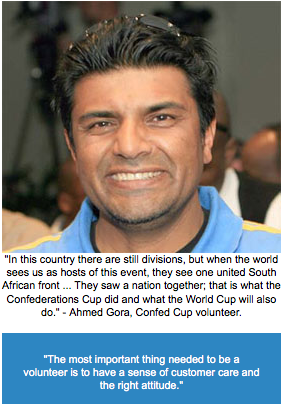 during the Confederations Cup in June that there was a very strong sense of patriotism.
during the Confederations Cup in June that there was a very strong sense of patriotism.
"There are foreign volunteers who want to see South Africa and the African continent succeed. The spirit is unbelievable, it is a common spirit of working together," he said.
He added that it was very important that the Volunteer Programme was launched in July. This was the month when all eyes were on South Africa as millions of people around the world celebrated the 91st birthday of our famous former president, Nelson Mandela.
Inspiration
"Our famous statesman, Mandela himself had been a volunteer-in-chief for 67 years of his adult life fighting for freedom, justice and peace. We therefore draw an inspiration from him as to what it is to be a volunteer and serve fellow mankind," Jordaan said.
The most important thing needed to be a volunteer is to have a sense of customer care and the right attitude, said Ms Onke Mjo, Manager of the 2010 FIFA World Cup Organising Committee Volunteer Programme.
- Mbulelo Baloyi
BENEFITS TO SMILE ABOUT
BENEFITS TO SMILE ABOUT sadminSouth Africans have a lot to smile about despite the current economic slowdown. The 2010 World Cup is almost here and we will reap the benefits long after it has gone.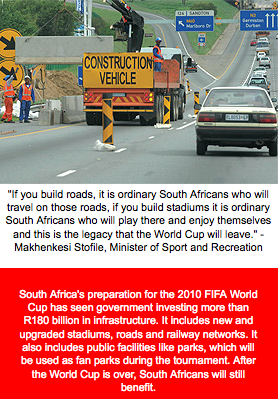
Among the most important benefits of hosting the World Cup is the development of many communities across South Africa.
Without the 2010 World Cup, the host cities and their neighbouring towns would not have some of the infrastructure built for the tournament.
Apart from improved infra-structure, the tournament will also attract more tourism to South Africa. All of this is helping to create jobs for local people.
Traffic problems
Another benefit is the new public transport system called the Bus Rapid Transit (BRT) system, which is developed in Johannesburg, Cape Town, Durban and the Nelson Mandela Metro.
The BRT system will help to solve the problem of too much traffic in the cities. This is caused by people using their own vehicles to travel to work due to a lack of public transport.
The new Gautrain, which is being built, will link Pretoria, Johannesburg and the OR Tambo International Airport. It will reduce traffic and make life much easier for the thousands of people who travel between these destinations every day.
In Durban, a new railway passenger station and a shopping centre are built near the new Moses Mabhida Stadium.
Stadiums
Besides the new and upgraded 2010 soccer stadiums in the host cities, existing stadiums in townships and towns near the host cities are also being upgraded to FIFA standards.
In Gauteng, Soweto's Orlando Stadium and the Rand Stadium are upgraded; in KwaZulu-Natal, the Wadley Stadium in Edendale near Pietermaritzburg and Cedric "Sugar Ray" Xulu Stadium in Clermont are upgraded; and in the Western Cape, the Athlone Stadium in Cape Town is upgraded. They will be used as training grounds by the 32 participating countries.
Airports
As many as three million tourists are expected during the 2010 World Cup. To handle the increase in air traffic, the country's major airports have been upgraded to become world-class facilities.
These include the Johannesburg, Cape Town and Durban international airports. Smaller airports like the Polokwane international airport in Limpopo has also been upgraded.
- Mbulelo Baloyi
BRT - GOING SAFER AND FASTER
BRT - GOING SAFER AND FASTER sadminThousands of people in Johannesburg travel long distances across the city every day to get to work and back. They will now be able to get there safer and faster with the Bus Rapid Transport system. The 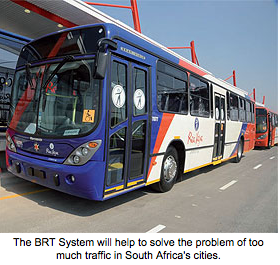 system is called Rea Vaya, which is SeSotho for 'we are going'.
system is called Rea Vaya, which is SeSotho for 'we are going'.
The Bus Rapid Transit (BRT) System is aimed at upgrading the public transport system in South Africa's main cities ahead of the 2010 FIFA World Cup.
Cities which will get the BRT system are Johannesburg, eThekwini (Durban), Tshwane (Pretoria), Cape Town and Nelson Mandela Metro (Port Elizabeth).
These cities will continue to reap the benefits long after the World Cup has come and gone. There will be less traffic, which means less accidents. People will also get to their workplaces faster.
Phases
The construction of the first phase of the Rea Vaya bus route has been completed. It includes special bus lanes on the major highways and city streets, as well as bus stations and ticketing centres.
- The first phase, Phase 1A, started at the end of August. It runs between Regina Mundi Church in Thokoza Park, Soweto and Ellis Park.
- The route will pass stations at Orlando Stadium, Westgate, Chancellor House, Beyers Naude Square, Carlton Centre, Fashion Square, Johannesburg Art Gallery, and the Doornfontein campus. It will drop passengers at the Ellis Park North and Ellis Park East stations.
- The second phase, Phase 1B, will run from Soweto past the universities of Johannesburg and the Witwatersrand, through to Sandton.
- The third phase, Phase 1C, will run in an east-west direction, from Alexandra to Cresta.
Buses
Some 143 buses have been put into operation in Phase 1A. They travel 25,5 kilometres and stop at 27 stations. It is expected that more than 69 000 passengers will travel on the buses every day.
Two kinds of buses are used on the Rea Vaya BRT routes. The bigger buses, called trunk buses, can carry 112 passengers. They have doors on the right-hand side and run in the special bus lanes.
The smaller buses have doors on both sides and can carry 75 passengers. They travel on the special BRT routes and on normal routes.
Control room
A control room checks security, traffic lights and road conditions 18 hours a day. If there is a breakdown, mechanical teams will be sent out immediately to remove the bus from the lane.
The control room also gives information to passengers. A voice-over system is used to help passengers who cannot read and those who are blind.
To limit delays, traffic lights on the BRT routes are activated to turn green as soon as the bus is near. This is done through the Rea Vaya control room in Martindale, Johannesburg.
A satellite tracking system ensures that the buses are exactly on time.
- Mbulelo Baloyi
DEBT COUNSELLING TO THE RESCUE
DEBT COUNSELLING TO THE RESCUE sadminDue to the current economic slowdown, many people are struggling to pay off their debt. Some people panic, ignore their debt or borrow more money to pay their accounts. If you cannot pay your debt, 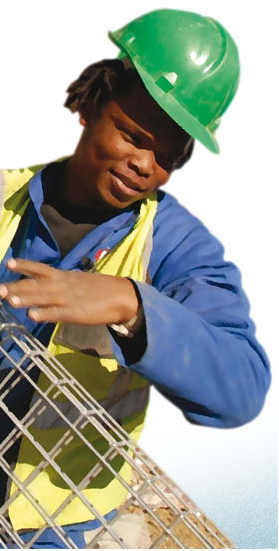 don't panic - there is help in the form of debt counselling. A debt counsellor will help you work out a budget and discuss a payment plan with your creditors. But you must make sure he or she is registered.
don't panic - there is help in the form of debt counselling. A debt counsellor will help you work out a budget and discuss a payment plan with your creditors. But you must make sure he or she is registered.
A debt counsellor is someone who is registered with the National Credit Regulator. He or she helps people who have debt-related problems. This includes being unable to pay monthly instalments or being blacklisted. Debt counsellors talk to credit providers and help to work out budgets and repayment plans.
There are about 1 020 registered debt counsellors in the country. All of them are checked to make sure that their practices are in line with the National Credit Act.
What you should know
- You can only go to a debt counsellor if you have already talked to your credit providers and they cannot help you. The National Credit Regulator has set up a fund to pay for your debt counselling fees if you are earning less than R2 500 per month. Ask your debt counsellor about this.
- All debt counsellors should have registration certificates showing their names and registration numbers. If you are not sure whether a debt counsellor is registered, you have the right to call the National Credit Regulator to confirm the details of the debt counsellor.
- Debt counsellors are not allowed to get money directly from you and then pay the credit providers on your behalf. They must use a Payment Distribution Agency to get the money from you. The Agency will then pay your credit providers on your behalf.
- You must find out about the fees of the debt counsellor before you start with debt counselling. You may exercise your right to negotiate the fee. There is more than one debt counsellor in most areas, so if you are not happy with the fee of one debt counsellor you can go to another one.
Benefit
It is important to know that once the debt counsellor talked to the credit providers and made payment arrangements with them, the credit provider has no right to repossess (take back) the goods that you bought on credit.
This is because the arrangements are made to ensure that the person who is in debt, as well as the credit provider, benefit from the process.
- Carol Netshifhefhe
For more information on debt counselling or to get a list of registered debt counsellors in your area, call the National Credit Regulator (NCR) 0860 627 627 or visit their website: www.ncr.org.za
For more information on debt counselling or to get a list of registered debt counsellors in your area, call the National Credit Regulator (NCR) 0860 627 627 or visit their website: www.ncr.org.za
EPISODE 1: IMBIZO JUNCTION KNOWING GOVERNMENT'S PLAN
EPISODE 1: IMBIZO JUNCTION KNOWING GOVERNMENT'S PLAN sadmin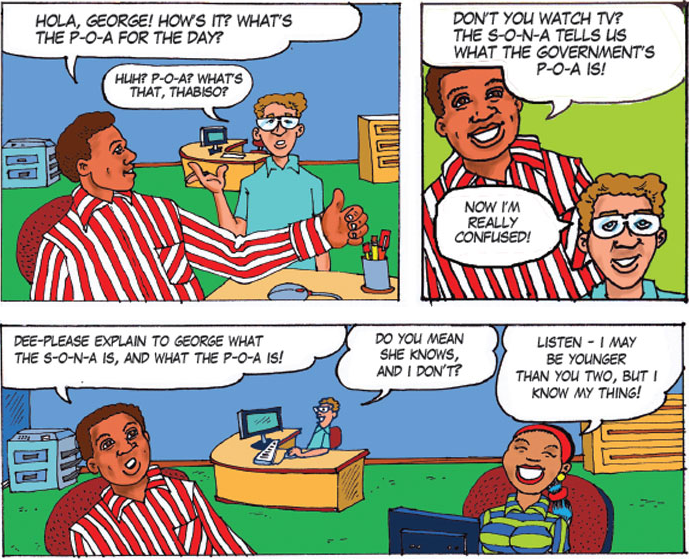
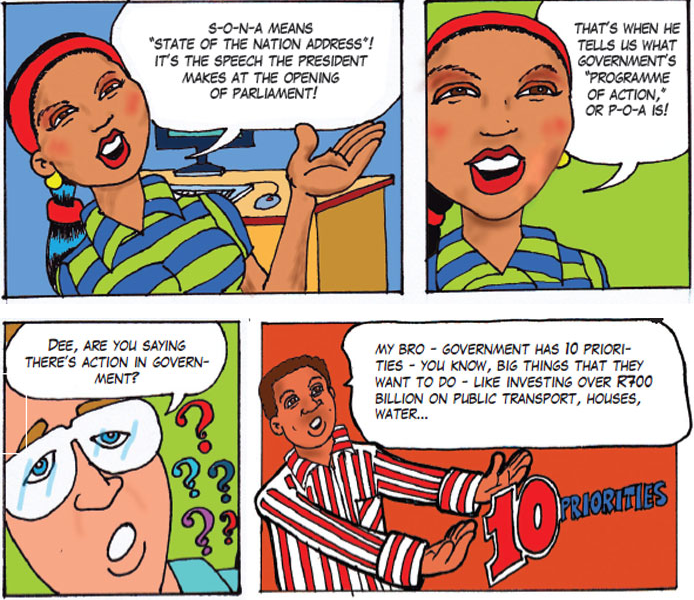
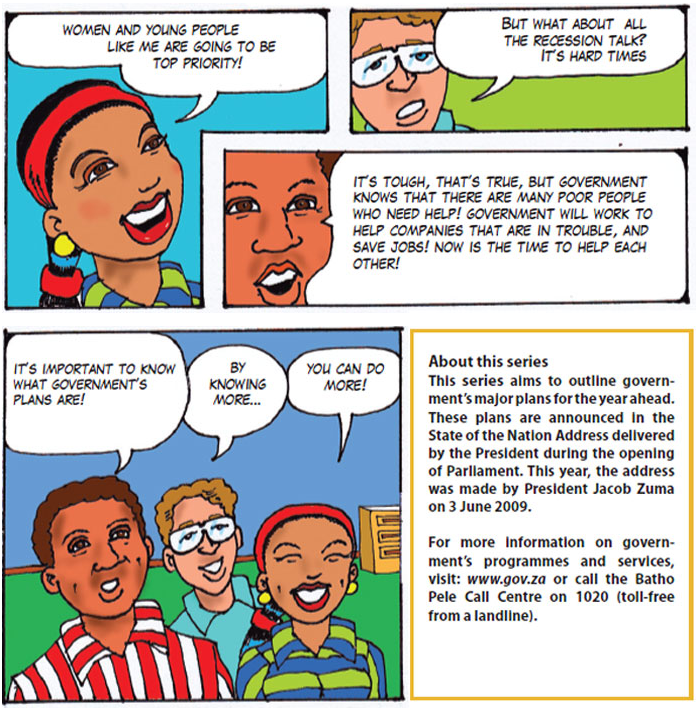
GIVE US A PIECE OF YOUR MIND
GIVE US A PIECE OF YOUR MIND sadminMaking their own map books cost schools for blind and partially sighted learners a lot of money and time. They have to use special Braille paper, string and glue. In addition, such maps are usually quite 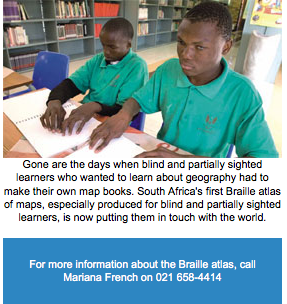 small and the information very limited.
small and the information very limited.
First for South Africa
To help these schools, the Department of Land Affairs introduced the first of its kind, a Braille atlas for blind learners this year. The atlases will open up a whole new world for partially sighted and blind people in South Africa.
"Producing this book is a first of its kind for South Africa. It shows Government's commitment to levelling the playing field between able and disabled persons," said Lulu Xingwana, Minister of Land Affairs.
Valuable tool
The atlas is a valuable educational tool for blind people who can read Braille. This is in line with our country's Constitution, which states that people with disabilities have the right to access of information.
The books are part of the school syllabus. They will make life much easier for learners when doing homework and class assignments.
Schools
The atlases were distributed to schools for the blind and partially blind throughout the country. They are used mainly by Grade 10, 11 and 12 learners studying Travel and Tourism and also by Grade 8 and 9 learners doing Social Sciences.
"Learners are now having great fun learning about the different provinces and cities in South Africa," said Mokhine Boshielo, a History Teacher at the Filadelfia School for Visual and Hearing Impaired Learners.
She said they aim to get an atlas for every learner in the school, as it is difficult for learners to share the books and read the Braille together.
Major step forward
"This atlas is a major step forward in the classroom. Hopefully our learners can soon start learning about other countries and continents with international Braille maps," Boshielo said.
Currently, the maps are of South Africa's provinces and regions only.
- Samona Murugan
KEEPING BLIND LEARNERS IN TOUCH WITH THE WORLD
KEEPING BLIND LEARNERS IN TOUCH WITH THE WORLD sadminMaking their own map books cost schools for blind and partially sighted learners a lot of money and time. They have to use special Braille paper, string and glue. In addition, such maps are usually quite 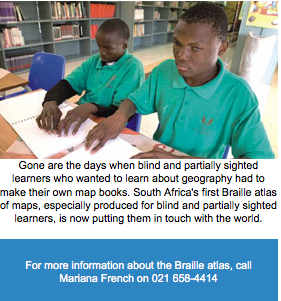 small and the information very limited.
small and the information very limited.
First for South Africa
To help these schools, the Department of Land Affairs introduced the first of its kind, a Braille atlas for blind learners this year. The atlases will open up a whole new world for partially sighted and blind people in South Africa.
"Producing this book is a first of its kind for South Africa. It shows Government's commitment to levelling the playing field between able and disabled persons," said Lulu Xingwana, Minister of Land Affairs.
Valuable tool
The atlas is a valuable educational tool for blind people who can read Braille. This is in line with our country's Constitution, which states that people with disabilities have the right to access of information.
The books are part of the school syllabus. They will make life much easier for learners when doing homework and class assignments.
Schools
The atlases were distributed to schools for the blind and partially blind throughout the country. They are used mainly by Grade 10, 11 and 12 learners studying Travel and Tourism and also by Grade 8 and 9 learners doing Social Sciences.
"Learners are now having great fun learning about the different provinces and cities in South Africa," said Mokhine Boshielo, a History Teacher at the Filadelfia School for Visual and Hearing Impaired Learners.
She said they aim to get an atlas for every learner in the school, as it is difficult for learners to share the books and read the Braille together.
Major step forward
"This atlas is a major step forward in the classroom. Hopefully our learners can soon start learning about other countries and continents with international Braille maps," Boshielo said.
Currently, the maps are of South Africa's provinces and regions only.
- Samona Murugan
KEEPING IT BRIEF
KEEPING IT BRIEF sadminFREE STATE
The Department of Cooperative Governance and Traditional Affairs recently approved a process to increase the number of women ward councillors. This was announced at the Women in Provincial and Local Government Summit held in Bloemfontein in August. The process is expected to be put into practice ahead of the local government elections in 2011. Since 2006, women councillors have increased from 29 to 40 per cent. The aim is to reach 50 per cent in 2011.
- BuaNews
EASTERN CAPE
The John Dube Disability Friendly Clinic in Scenery Park, Buffalo City (Formerly East London) has been upgraded. This will ensure that the needs of all patients are met, including those who use wheelchairs and the deaf. Disability toilets have been fixed, ramps were built and special beds were bought for people in wheelchairs. Sign language interpreters will help nursing staff to communicate with deaf patients. The clinic will also cater for those affected by HIV and AIDS.
- BuaNews
KWAZULU-NATAL
To bring government services closer to people living in remote rural areas, the province's Department of Social Development is to build 27 one-stop development centres. Services will include the South African Social Security Agency (SASSA), the departments of health, home affairs and labour and the South African Police Service. The centres will also be a market where local communities can sell their produce. In addition, each centre will have its own community garden.
- BuaNews
MPUMALANGA
A Business Development Resources Centre (IBDRC) was opened in Siyathemba township, outside Balfour in August. The centre will encourage the growth of small, micro and medium enterprises (SMMEs) in the area. It is a joint project by the Small Enterprise Development Agency (Seda) and mining company, Great Basin Gold. Services at the centre include business information and advice, as well as improving access to finance and training, mentoring and coaching in business skills.
- BuaNews
LIMPOPO
President Jacob Zuma launched the Comprehensive Rural Development Programme (CRDP) in the village of Muyexe in Giyani in August. The CRDP is government's national plan to fight poverty, hunger, unemployment and lack of development in rural areas. It aims to create jobs and boost economic growth in rural communities. It will also ensure the delivery of clean water, decent shelter and proper sanitation.
- BuaNews
NORTHERN CAPE
The provincial government will hold a summit this month to discuss the effects of the economic slowdown in the province. It forms part of efforts to boost economic growth and development in the region. The meeting will include role players from business, labour and civil society. It will address issues related to co-operation between different sectors of government, as well as the private sector and other social partners.
- BuaNews
OUR HERITAGE, OUR WEALTH...
OUR HERITAGE, OUR WEALTH... sadmin PLEASE NOTE:
The games on this page are not a competitions. They are only for fun, so don't send your answers to Vuk'uzenzele.
In South Africa, September is Heritage Month. This is a time when we celebrate our rich cultural heritage.
South Africa has eight World Heritage Sites. World Heritage Sites are places in different countries that are considered to be of "outstanding value to humanity". The purpose of World Heritage Sites is to identify, protect and preserve cultural and natural heritage around the world. There are more than 850 World Heritage Sites in 141 countries.
The following places in South Africa are World Heritage Sites:
- iSimangaliso Wetland Park
- Robben Island
- Cradle of Humankind
- uKhahlamba Drakensberg Park
- Cape Floral Region
- Mapungubwe Cultural Landscape
- Vredefort Dome
- Richtersveld Landscape
What is Heritage?
Heritage is something that is passed down from generation to generation, like a legacy. It includes things like traditions, culture, land, objects, buildings, monuments and sacred places
uNsCraMble
Read the list of World Heritage Sites above and uNsCraMble the names under the photos below
Print the image below to complete this game...
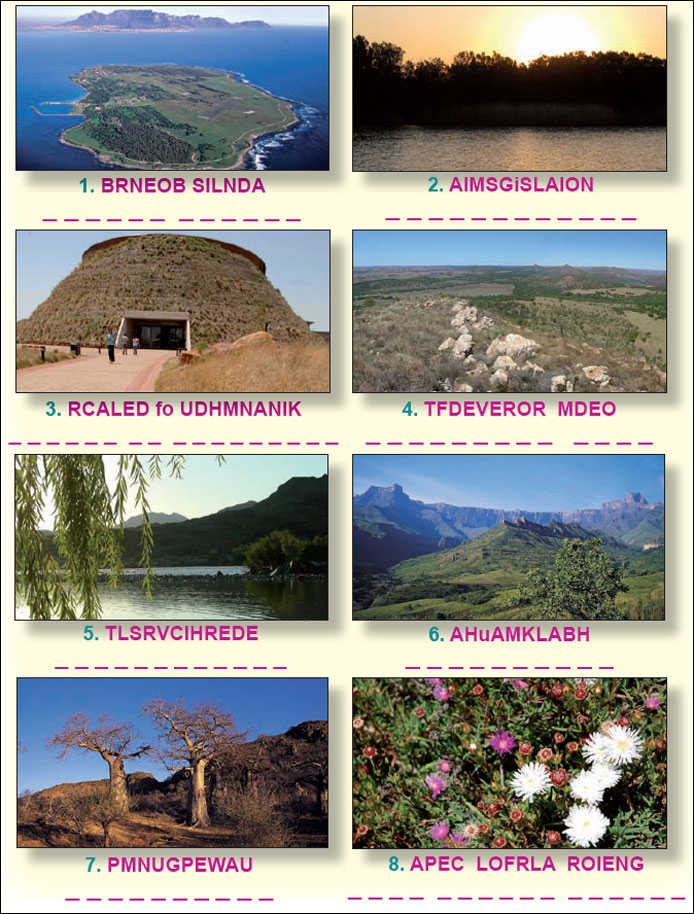
CLICK HERE FOR THE ANSWER
Fill in the missing words
Print the image below to complete this game...

CLICK HERE FOR THE ANSWER
PASSIONATE ABOUT SERVING HIS COUNTRY
PASSIONATE ABOUT SERVING HIS COUNTRY sadmin"I studied medicine because I was passionate about it and have always loved helping people." These are not just empty words from Bongani Mahlangu. A study loan from government gave him an 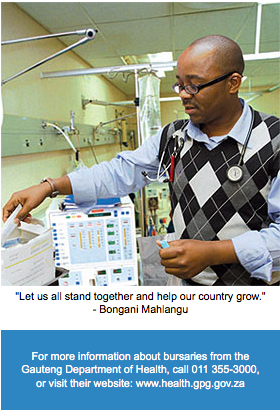 opportunity of a lifetime to study medicine in Cuba. He is now committed to serving the people of South Africa in the public sector, because it is the tax payers' money that helped him to become a doctor.
opportunity of a lifetime to study medicine in Cuba. He is now committed to serving the people of South Africa in the public sector, because it is the tax payers' money that helped him to become a doctor.
Bongani Mahlangu was born on 22 July 1977 in Soweto. The family was poor and he had a hard life, but he sees nothing extraordinary about how he grew up. He said his life in Soweto shaped who he is today.
"My life was not different to any other child in Soweto. The challenges were there and I had to face them," Mahlangu said.
Life-long dream
He went to many different schools, because the family was always moving from one area to another. "I finally finished school in Kwa-Ndebele, " Mahlangu said.
After finishing school, he completed a certificate course in business and office management. But he wanted to study for a degree and registered for civil engineering at the then Technikon SA. He had to work part time to pay for his studies.
In September 1999, his life-long dream came true. "I saw an advert in a newspaper. The Gauteng Department of Health advertised bursaries for disadvantaged youth to study medicine in Cuba," he said. "I thought I would never be selected as I didn't think I would meet the criteria."
He applied anyway and to his surprise he was one of the few who got the bursary. "It was an opportunity of a lifetime," he said.
Satisfaction
Mahlangu said his stay in Cuba was interesting, but it was sometimes hard for him because he missed home a lot.
He completed his studies and returned to South Africa in 2007. He now works as an intern at Natalspruit Hospital and wants to remain in the public sector even after his internship. "I believe I owe it to the people of South Africa to serve and help them. It is after all the tax payers' money which helped me to become a doctor," he said.
Passion
"People shouldn't do medicine for the fame and glamour of being a doctor. Medicine is for people with passion, who love helping other people," Mahlangu said.
"It is not about making money, it's the satisfaction of seeing patients' smile when they are released from their pain. Knowing that you healed people is what makes a doctor sleep better at night."
Mahlangu says he wants to study further and become a medical engineer. He vows that even after that he will stay in the public sector to serve the people of his country.
His advice to youth is: "With all the opportunities available for youth, the sky is the limit. Let us all stand together and help our country grow."
- Carol Netshifhefhe
SOUTH AFRICA TO SHOWCASE ITS WORLD HERITAGE
SOUTH AFRICA TO SHOWCASE ITS WORLD HERITAGE sadminSouth Africa is blessed with a lot of natural beauty. Among our many tourist attractions, are eight World Heritage Sites. September is Tourism and Heritage month and our tourism officials are preparing to welcome the world to these sites.
It is less than a year before South Africa hosts the 2010 FIFA World Cup. Thousands of soccer fans are expected to visit our country for this major event. September has been chosen to promote the country's World Heritage Sites ahead of the tournament.
The national and provincial departments of tourism, arts and culture are working with tourism organisations and the 2010 FIFA World Cup Organising Committee's Legacy Project. They will start various programmes to promote both the soccer tournament and our World Heritage Sites.
Protected areas
The World Heritage Committee of the United Nations Educational, Scientific and Cultural Organisation (UNESCO) has declared eight sites in South Africa as World Heritage Sites.
They are protected areas because of their environmental, cultural, natural, historical and heritage importance to the world. They are also important tourist attractions. This means communities living near them will benefit because more tourism creates more jobs.
The eight sites are:
The iSimangaliso Wetland Park is South Africa's first World Heritage Site. It was declared in 1999 for its exceptional plants and animals, including about 521 kinds of birds. Formerly known as the Greater St Lucia Wetland Park, it was renamed iSimangaliso (meaning 'wonder' in isiZulu) in 2007.
Robben Island lies 11 km offshore from Cape Town. It is most famous as the place where former President Nelson Mandela spent 18 of his 27 years in prison. It was declared a World Heritage site of cultural significance in 1999.
The Cradle of Humankind includes the Sterkfontein Caves and covers the Sterkfontein, Swartkrans, Kromdraai area. First declared a World Heritage Site in 1999, it is situated in Gauteng and the North West province.
The uKhahlamba Drakensberg Park lies in the west of KwaZulu-Natal Midlands on the Lesotho border. It was declared a World Heritage Site in 2000.
The Mapungubwe Cultural Landscape is also known as the "place of the stone of wisdom." It is situated in the Mapungubwe National Park in Limpopo and was declared a World Heritage Site in 2003 for its cultural importance.
The Cape Floral Region, situated in the Eastern and Western Cape provinces, was declared a World Heritage Site in 2004. It is one of the richest areas for plants in the world.
The Vredefort Dome was declared a World Heritage Site in 2005. It is two billion years old and was formed when a meteorite 10 km in diameter hit the earth creating a huge crater.
The Richtersveld Cultural and Botanical Landscape in the Northern Cape covers 160 000 hectares of mountainous desert. It was declared a World Heritage Site in 2007 for its unusual plant life.
- Mbulelo Baloyi
TACKLING THE SWINE FLU CHALLENGE
TACKLING THE SWINE FLU CHALLENGE sadminMore than 3 500 cases of A(H1N1) influenza, commonly known as swine flu, were reported in South Africa by the middle of August. Deaths were reported in the Western Cape, KwaZulu-Natal, Eastern 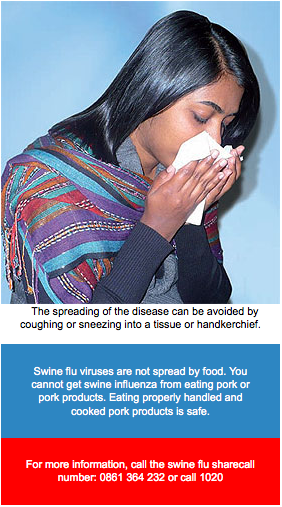 Cape and Gauteng. Government is tackling the swine flu challenge by stepping up its plan to deal with the disease. This includes a major national awareness campaign.
Cape and Gauteng. Government is tackling the swine flu challenge by stepping up its plan to deal with the disease. This includes a major national awareness campaign.
The awareness campaign is run by the national Department of Health in co-operation with some other government departments. These include the Department of Basic Education and the Department of Higher Education and Training.
The campaign is run in addition to steps that government has already taken to prevent the further spreading of the disease.
Hotline
The Department of Health set up a national swine flu hotline aimed at health workers who have questions about A(H1N1). The hotline is operated by the National Institute of Communicable Diseases.
In addition, a sharecall number for members of the public with questions or worries was also set up.
Government has decided not to close schools and other public places like shopping centres. This is because experience in other countries has shown that closure of public places like schools and shopping malls do not prevent the spread of the infection.
The national campaign includes advertisements on national television and radio, as well as on community radio stations.
Information
To spread awareness as widely as possible, pamphlets and posters with information about the disease are distributed to local communities in the languages spoken there. This information is also distributed at taxi ranks, shopping malls and other public places.
In addition, the department has sent letters to heads of schools and universities explaining the challenges of the epidemic with advice on steps to be taken.
Letters have also been sent to religious leaders asking them to share information on the virus with their followers.
Similar letters have been sent to organised labour and business, traditional leaders, community development workers and social workers.
Treatment
Swine flu is an airborne (carried by air) disease that spreads in the same way as seasonal flu, through coughing and sneezing. It cannot be caught by eating pork.
The spreading of the disease can be avoided by coughing or sneezing into a tissue or handkerchief.
The Department of Health urges people to wash their hands regularly and avoid crowded areas, especially if people have symptoms of the flu.
Swine flu can be treated with medication that fights viral infections. This medication is available in South Africa, but may only be used under a medical doctor's direction.
Symptoms can be divided into "mild", "moderate" and "severe". Anyone with moderate or severe symptoms should visit their doctor or clinic as soon as possible.
- Mbulelo Baloyi
VOLUNTEERS DOING IT FOR THEIR COUNTRY
VOLUNTEERS DOING IT FOR THEIR COUNTRY sadmin "Ask not what your country can do for you, but what you can do for your country." These words by former United States President, John F Kennedy, ring true as South Africa is getting ready to host the 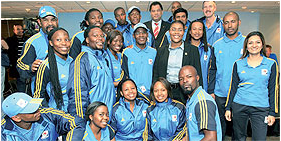 2010 FIFA World Cup. Volunteers will be the face of the tournament giving their time and service to their country.
2010 FIFA World Cup. Volunteers will be the face of the tournament giving their time and service to their country.
The success of the 2009 Con-fed Cup has created a positive mood among South Africans. Many are feeling more patriotic about their country. Part of this success was due to the important role played by volunteers during the tournament.
Best ever
"South Africa will rely heavily on the services of volunteers to make the World Cup a success," said Dr Danny Jordaan, 2010 FIFA World Cup Organising Committee Chief Executive Officer.
"During the FIFA Confederations Cup, volunteers did an outstanding job, and we expect them to improve on their strengths to make sure that we host the best world cup ever," he said.
Make things happen
Volunteers play a very important role in making things happen - from taking people to their seats, to helping the media and foreign language speakers, welcoming people at the airport and driving guests around.
There was a total of 4 000 local volunteers during the 2009 FIFA Confederation Cup. It took place at four different host cities and involved eight countries.
Applications for the 2010 FIFA World Cup Volunteer Programme opened on 20 July and closed on 31 August 2009. The aim was to sign up 15 000 volunteers for 2010. The response was overwhelming with more than 15 000 applications received on the first day.
Worldwide
Altogether 32 countries, including South Africa, will be represented at the World Cup. The tournament will be played at 10 stadiums in nine cities.
The Volunteer Programme was open to everyone worldwide, but the majority of the volunteers are from South Africa. Ten per cent were chosen from other African countries, while another ten per cent are from the rest of the world.
Training
Volunteers will be trained in different service areas. These include things like marketing, media, receiving important guests, welcome and information services, transportation, administration, IT, telecommunication services and language support.
Volunteers will be trained in March and April next year in the nine host cities. They will not be paid a salary for their work, but will get an allowance for travel expenses. They will also get meals on the days when they work. In addition, volunteers will get certificates of acknowledgement for their service.
- Mbulelo Baloyi